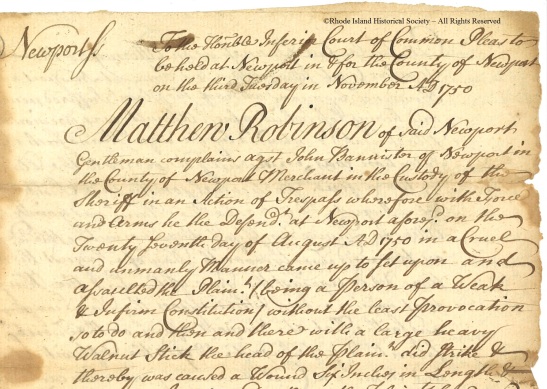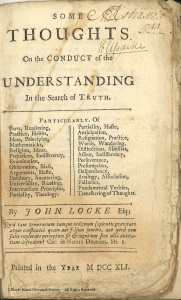A 1750 Walnut Stick Attack
Matthew Robinson (1709-1795) was a Newport lawyer. Supposedly minding his own business, walking the street in 1750 when he was attacked by merchant John Banister yielding a “large heavy walnut stick”. So it is documented in a complaint found in the John Banister Papers.
“Matthew Robinson of said Newport, Gentleman complains against John Banister of Newport in the County of Newport Merchant in the custody of the Sheriff in an action of trespass wherefore with the Force and Arms he the defendant at Newport aforesaid on the twenty seventh day of August AD 1750 in a cruel and inhumane manner came up to set upon and assaulted the plaintiff being a person of a weak & infirm constitution without the least provocation so to do and then and there with a large heavy Walnut Stick the head of the plaintiff did strike and thereby was caused a wound six inches in length + half an inch in depth on the plaintiff’s head and at said time and place the defendant with said Walnut Stick the left arm of the plaintiff diverse blows did strike by means where of the same was very grievously bruised to the bone from his elbow to his finger ends so that his said arm is rendered almost entirely useless + by the occasion of which wounds the plaintiff was put into great anguish + pain which produced a high fever whereby the life of the plaintiff was brought into great danger so that the plaintiff for the space of three weeks was confined to his chamber and could not attend during that time on his lawfull business as an attorney at the Superior Courts fitting within said time at Newport and Providence by means whereof the plaintiff suffered much and heavy loss which aforesaid assault was previously machinated + intended by the defendant particularly on the last Sunday of August then there did do against the Peace of the Lord the King that now is…”
Matthew Robinson was the only son of Robert Robinson who had been appointed Searcher of the Customs by Queen Anne and held other prominent Colonial posts. Matthew studied law in Boston and was fluent on both Greek and Latin. At the age of approximately 26 he opened a law office in Newport where he pursued his business eventually argued cased at the Superior Courts of the Colony. According to the Biographical Cyclopedia of Representative Men of Rhode Island (Providence: National Biographical Publishing Co., 1881), “About the year 1750 he moved to Narragansett”, where he purchased a landed estate eventually totaling 800 acres. Did the attack by John Banister scare him out of Newport? The timing seems suspiciously close.
John Banister (1707-1767) was the oldest surviving child of Boston merchant Thomas Banister (c1683-1716). By 1728, he joined the mercantile partnership of Minot & Banister in Boston. Circa 1736, he left this firm and moved to Newport, R.I. There in 1737 he married Hermoine Pelham (1718-1765), a granddaughter of Gov. Benedict Arnold.
Banister quickly established himself as a leading Newport merchant, trading with England, the West Indies (particularly the Bay of Honduras) and elsewhere. He also engaged in privateering and the slave trade. In 1752, he held one of the last public slave auctions in Rhode Island at his store, describing them in advertisements as “the finest cargo of slaves ever brought into New England (see Coughtry). Toward the end of his life, he moved to Middletown, R.I., where he died in 1767.
But back to Robinson. “On his estate, which is near the spot where now stands the railroad station in Kingston, he built an elegant mansion, after the style of an English lodge, which he called ‘Hopewell.” This reference to Hopewell helped us settle a mystery when we received an inquiry from an editor of the John Jay Papers at Columbia University who was trying to identify the author of a letter written to John Jay on 17 Jun 1792. In the letter he encourages Jay to visit him at Hopewell and see some of his library. Robinson was also a bibliophile and “had one of the largest and best-selected private libraries in the colony.” The letter is signed M. Robinson but we needed to confirm the identity.
The Rhode Island Historical Society is lucky enough to hold at least one of the books owned by Matthew Robinson. John Locke’s 1741 London imprint of Some Thoughts on the Conduct of the Understanding in Search of Truth is signed by Robinson with a date of 1744. It also has a bookplate which identifies that it became part of the library of lawyer, historian and bibliophile Wilkins Updike, Esq. (1784-1867) of Kingston.
The book was generously given to the R.I.H.S. in 1891 with many others by his grandson, renowned printer Daniel Berkeley Updike (1860-1941). D.B.Updike’s note on the inside cover of the Locke imprint reads: “This book belonged to Matthew Robinson of Hopewell Lodge and has his autograph.” Thus we have another source connecting our Matthew Robinson to the term Hopewell and an example of his signature to compare with the letter to John Jay.
Thankfully Robinson survived the walnut stick attack of 1750 and lived another 45 years collecting his books and corresponding with friends from the safety of his estate, Hopewell Lodge.
For more primary source examples of the Rhode Island Colonial Court System where Robinson lodged his complaint see our online gallery Colonial Justice.
~Phoebe Bean, Librarian




